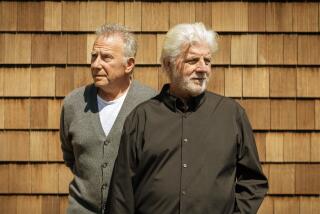Bill Watrous Gets His Second Wind
Bill Watrous says that the trombone, far from being dead or dormant, just needs to come out of the shadows.
“The problem is not the shortage of talent, but the profusion of synthesizers,” he says. “Also, what with electric keyboards and electric basses and even electric drums, the trombone, with those low over-tones, can be totally buried. It can’t squeal like a saxophone or pierce like a trumpet; with all that competition from highly miked rhythm sections, it comes off like a powerless entity.”
Watrous, a second-generation trombonist whose father played with Paul Whiteman, was a product of the post-J. J. Johnson generation, when there were still plenty of big-band outlets for the horn of his choice. During the 1960s, he worked with Quincy Jones, Woody Herman, Johnny Richards, briefly with Count Basie and with Bobby Rosengarden’s band on “The Dick Cavett Show.”
After leading his own New York band, the Manhattan Wildlife Refuge (recorded under the aegis of the late John Hammond), Watrous moved to Los Angeles in 1976 and found that despite a decade of major New York successes, demands for his services were about as numerous as calls for a left-handed exponent of the ancient Greek zither.
“I was the best-kept secret in town,” he says. “If it hadn’t been for one or two contractors who began hiring me, I might still be scuffling.”
He has again tried his hand as a leader, appearing now and then with his own orchestra at Donte’s. At present, he is waiting for his new album, “Reflections” (Soundwings SWD-2104), to break out for him.
Produced by an old friend, the composer/arranger Patrick Williams, the album reveals new facets of his talent. Here and there he sings (on David Frishberg’s “Dear Bix”) or whistles in unison with his horn (on “The Slap Maxwell Theme”). On one number, “Why Not,” he overdubbed four trombone parts.
An artist of extraordinary virtuosity and versatility, Watrous has managed to blend the easy legato of Tommy Dorsey and the bebop concepts of J. J. Johnson to create a persona that spans two generations.
“J. J. was one of my first idols,” he says. “When I met him, I said, ‘J. J., do you remember this?’ Then I picked up my horn and played, note for note, a solo he had recorded on ‘Cry Me a River.’
“It’s hard to get really close to someone in style, but you can imitate up to a point, so he recognized himself, looked at me in amazement and said, ‘I don’t recall doing that!’
“J. J. is one of my cultural heroes, along with people like Benny Carter, Ray Brown, Sweets Edison. Whenever I speak at a college clinic, if some kid says, ‘Hey, man, I’m a trombone player,’ I ask if he’s listened to J. J., and if he hasn’t I tell him to get as many of his albums as he can. That’s essential education.”
Education has played a vital role in sparing the trombone from desuetude. This summer, Watrous attended the annual meeting of the National Trombone Workshop at Vanderbilt University in Nashville. “The workshop began many years back with, believe it or not, exactly 76 trombones. An offshoot of it is the International Trombone Assn., of which I’m a life member. We have our own magazine, with a worldwide circulation that by now is well over 3,000.
“The college bands are overflowing with talented youngsters who could have gone on to become heroes in another time. In the Tommy Dorsey days, there were vehicles that gave exposure to musicians coming up--the big bands, which were yesterday’s counterpart to the rock acts of the 1980s. Today, when they graduate, no matter how good they may be, where are these humongous talents going to get a job?”
Among those who do not suffer these privations are several Los Angeles musicians Watrous admires: “Chauncey Welch is a tremendous player; so are Charlie Loper and Bill Booth. Dick Nash doesn’t get the credit he deserves. And there are younger men like Jim Pugh, who used to be with Woody Herman, and of course John Fedchock, who’s still with the Herman band, writing a lot of the charts and playing great solos.”
Watrous hopes that the current album will bring him to the point at which he can take to the road with a band something like his new Soundwings ensemble, a 24-piece group that includes a 14-member string section. “I realize how hard it is to travel with a band that large, but I’m going to find some way to figure it out. It’s going to be an interesting challenge.”
The difficult he has done right now; the impossible, if it takes a little while, could benefit audiences that may not realize what they are missing.
More to Read
The biggest entertainment stories
Get our big stories about Hollywood, film, television, music, arts, culture and more right in your inbox as soon as they publish.
You may occasionally receive promotional content from the Los Angeles Times.






